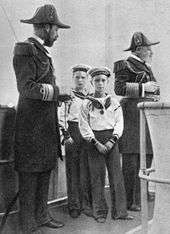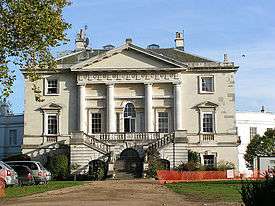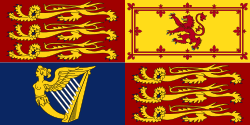White Lodge, Richmond Park
| White Lodge | |
|---|---|
|
White Lodge, Richmond Park | |
| Location | Richmond Park, London Borough of Richmond upon Thames |
| Coordinates | 51°26′43″N 0°15′53″W / 51.4452°N 0.2648°WCoordinates: 51°26′43″N 0°15′53″W / 51.4452°N 0.2648°W |
| Built | 1727–30 |
| Architect | Roger Morris |
| Architectural style(s) | English Palladian |
Listed Building – Grade I | |
| Official name: White Lodge | |
| Designated | 10 March 1981 |
| Reference no. | 1250045[1] |
 Location in Greater London | |
White Lodge is a Grade I listed[1] Georgian house situated in Richmond Park, in the London Borough of Richmond upon Thames. Formerly a royal residence, it now houses the Royal Ballet Lower School, instructing students aged 11–16.
Early history

The house was built as a hunting lodge for George II, by the architect Roger Morris, and construction begun shortly after his accession to the throne in 1727. Completed in 1730 and originally called Stone Lodge, the house was renamed New Lodge shortly afterwards to distinguish itself from nearby Old Lodge,[2] which was demolished in 1841. Old Lodge itself had been built by George II[3] for Britain's first prime minister, Sir Robert Walpole, who frequented it, particularly to hunt at the estate. Walpole said that he could "do more business there (Old Lodge) than he could in town".[4][5]
Queen Caroline, consort of George II, stayed at the new lodge frequently and, on her death in 1737, White Lodge passed to her friend Sir Robert Walpole, the Prime Minister. After his death, it came to Queen Caroline's daughter, Princess Amelia, in 1751. The Princess, who also became the ranger of Richmond Park, closed the entire park to the public, except to distinguished friends and those with permits, sparking public outrage.[6] In 1758, a court case made by a local brewer against a park gatekeeper eventually overturned the Princess's order, and the park was once again opened to the public.[6] Princess Amelia is remembered for adding the two white wings to the main lodge, which remain to this day. They were designed by Stephen Wright.[7][8]
The Prime Minister, John Stuart, 3rd Earl of Bute, became Ranger of Richmond Park after the Princess's resignation in 1760.[9] The British Magazine for January 1761 lists Lord Bute as the Ranger with his Deputy Ranger being Sir Sidney Meadows (d.1792).[10] Although White Lodge remained Lord Bute's official address, he was also entitled to the use of White Lodge's neighbour, Old Lodge,[11] which would house the Meadows family, who were the Prime Minister's extended family: The Royal Collection holds an etching, dated 1780, by George Barret, Sr. entitled The Lodge in Richmond Park, the residence of Philip Meadows Esq. (1708–81), who was the Richmond Park Deputy Ranger and the brother of Sir Sidney Meadows; their father being Sir Philip Meadows (d.1757). Sir Sidney and his brother Philip were related to the Prime Minister: Philip's wife was Lady Frances Meadows, née Pierrepont, who was the first cousin of the Prime Minister's wife, Mary Stuart Wortley.[12][13]
It was during the Bute-Meadows period that the name White Lodge first appeared, in the journal of Lady Mary Coke. In her entry for Sunday 24 July 1768 she says that went to Richmond Park hoping to catch a glimpse of "their Majestys" (George III and Queen Charlotte), "tho' they are always at the White Lodge on a Sunday".[7]
After restoration of the house following disrepair at the close of the 18th century, George III gave the house to another Prime Minister, Henry Addington, 1st Viscount Sidmouth, who enclosed the lodge's first private gardens in 1805. The King (affectionately called Farmer George for his enthusiasm for farming and gardening) made himself ranger, and Lord Sidmouth was made deputy ranger. On 10 September 1805, six weeks before the Battle of Trafalgar, Horatio Nelson, 1st Viscount Nelson, visited Lord Sidmouth at White Lodge and is said to have explained his battle plan to him there.[7]
19th century
.jpg)
After Viscount Sidmouth died in 1844, Queen Victoria gave the house to her aunt – the last surviving daughter of George III – Princess Mary, Duchess of Gloucester and Edinburgh. After her death in 1857, Prince Albert decided on White Lodge as a suitable secluded location for his son the Prince of Wales, the future Edward VII of the United Kingdom, during his minority and education. Although the Prince of Wales favoured stimulating company to hard study, Prince Albert kept him here in seclusion, with only five companions, two of whom were tutors, the Reverend Charles Feral Tarver, his Latin tutor and chaplain and Frederick Waymouth Gibbs. Understandably, the Prince of Wales found the few years at White Lodge boring.
After the Prince of Wales was sent to Ireland to continue his training, Queen Victoria, desperately grieving the death of her mother, the Duchess of Kent, came to White Lodge with Prince Albert in the early months of 1861. This was only the first of two deaths in her family that year. On 14 December, Prince Albert died of typhoid fever. The Queen was devastated, and never came out of mourning during the remaining 40 years of her life.[14][15]
Teck family and the birth of Edward VIII


The next occupants of the Lodge were Prince Francis, Duke of Teck and his wife, the former Princess Mary Adelaide of Cambridge, who were given use of the house by the mourning Queen Victoria in 1869. Princess Mary Adelaide, a granddaughter of George III and therefore first cousin to the queen, was famous for her extravagance. Requests for a higher income from the Queen were unsuccessful. Debts increased, and the family fled abroad during the 1880s to escape their creditors.
In 1891, the aged Queen, anxious to find a bride for her grandson, Prince Albert Victor, Duke of Clarence, settled on Princess Mary Adelaide's daughter, Victoria Mary. Following Prince Albert Victor's death a few months before the marriage in 1892, Victoria Mary married his brother, Prince George, Duke of York, the future George V in 1893. In 1894, the Duchess of York gave birth to her first child, the future Edward VIII, at White Lodge.[16] Queen Victoria visited the Lodge to see the Prince shortly afterwards. He was baptised Edward Albert Christian George Andrew Patrick David in the Green Drawing Room of White Lodge on 16 July 1894 by Edward White Benson, Archbishop of Canterbury.[N 1][17]
Three years later, the Duchess of Teck died, followed by the Duke of Teck in 1900.
20th century
After Queen Victoria's death, the Lodge was occupied by Eliza Emma Hartmann, a wealthy widow prominent in London society,[18] who was declared bankrupt in 1909. The house returned to royal use in 1923, during the honeymoon of Prince Albert, Duke of York, the future George VI, and the Duchess of York. Queen Mary, who had lived at White Lodge with her mother, Princess Mary Adelaide, insisted that they make their home at the Lodge. They remained there until late in 1925 after which the building was leased out by the Crown Estate.[19]
From then on, the house was occupied by various private residents including, from 1927, Arthur Lee, 1st Viscount Lee of Fareham.[7] The last private resident was Colonel James Veitch, who lived at White Lodge until 1954.[7]
Royal Ballet School
In 1955, the Sadler's Wells Ballet School was granted the use of White Lodge on a permanent basis. The school was later granted a Royal Charter and became the Royal Ballet School in 1956.[20] It is now recognised as one of the leading ballet schools in the world.[21]
As part of its redevelopment programme, the Royal Ballet School relocated and enlarged its ballet museum to include a gallery and collections relating to the history of White Lodge. The museum opened to the public in 2009[22] but closed in 2015.[23]
See also
Notes
- ↑ His twelve godparents were: Queen Victoria (his paternal great-grandmother); the King and Queen of Denmark (his paternal great-grandparents, for whom his maternal uncle Prince Adolphus of Teck and his paternal aunt the Duchess of Fife stood proxy); the King of Württemberg (his mother's distant cousin, for whom his granduncle the Duke of Connaught stood proxy); the Queen of Greece (his grandaunt, for whom his paternal aunt Princess Victoria of Wales stood proxy); the Duke of Saxe-Coburg and Gotha (his granduncle, for whom Prince Louis of Battenberg stood proxy); the Prince and Princess of Wales (his paternal grandparents); the Tsarevich (his father's cousin); the Duke of Cambridge (his maternal grand-uncle and Queen Victoria's cousin); and the Duke and Duchess of Teck (his maternal grandparents).
References
- 1 2 Historic England. "White Lodge (1250045)". National Heritage List for England. Retrieved 26 June 2015.
- ↑ Cloake, John (1996). Palaces and Parks of Richmond and Kew, vol.II. London: Phillimore & Co Ltd. p. 105. ISBN 978-1860770234.
- ↑ Plaidy, Jean (2012). "Queen Caroline – Georgian Series". Random House. Retrieved 15 April 2015.
- ↑ Cloake, John (1995). "Palaces and Parks of Richmond and Kew". Phillimore. Retrieved 10 April 2015.
Walpole went regularly to the park at weekends to hunt and to stay at Old Lodge where, he claimed, he could 'do more business than he could in town'.
- ↑ Brady, John Henry (1838). "A new pocket guide to London and its environs". Parker. p. 495). Retrieved 15 April 2016.
- 1 2 Lankester, Max (2011). "History" in Guide to Richmond Park. London: Friends of Richmond Park. pp. 85–87. ISBN 978-0-9567469-0-0.
- 1 2 3 4 5 "White Lodge, Richmond Park" (PDF). Richmond Libraries Local studies collection: Local history notes. London Borough of Richmond upon Thames. Retrieved 16 February 2015.
- ↑ "White Lodge (New Lodge) (Stone Lodge)". The DiCamillo Companion to British and Irish Country Houses. Retrieved 16 February 2015.
- ↑ "The Biographical Magazine: Containing Portraits of Eminent ...(Earl of Bute)". London. 1816. Retrieved 10 April 2016.
...the Monarch – (George II)- deceased in 1760 and after a short period, the rangership of Richmond Park was taken from the princess Amelia and bestowed upon the Earl of Bute
- ↑ Smolette, T G (1761). "London Magazine – Promotions". James Rivington & James Fletcher. p. 335. Retrieved 11 April 2015.
Promotions Lord Bute Ranger Richmond Park Sidney Meadows Deputy Ranger Richmond Park
- ↑ "White Lodge, Richmond Park" (PDF). Richmond Libraries Local studies collection: Local history notes. London Borough of Richmond upon Thames. Retrieved 15 April 2016.
Princess Amelia was succeeded as Ranger by John, Earl of Bute, who lived in ... "We (Lady Coke et al) return'd home by Richmond Park, & went past both the Lodges (Old Lodge and (New) White Lodge)".....
- ↑ "The Lodge in Richmond Park, the residence of Philip Meadows Esq. – After George Barret (c. 1767–1842)". Royal Collection Trust. Retrieved 10 April 2016.
View of White Lodge in Richmond Park, by a pond or river. Horses under trees
- ↑ Glover, Stephen (1829). "The History of the County of Derby: Drawn Up from Actual Observation, and from the Best Authorities; Containing a Variety of Geological, Mineralogical, Commercial, and Statistical Information, Volume 2, Part 1". Stephen Glover, publisher. p. 100. Retrieved 10 April 2014.
Philip Meadows Esq., deputy ranger of Richmond Park, was the son of Sir Philip Meadows...married in 1734 Frances, daughter of the 2nd Duke of Kingston....
- ↑ Darby, Elizabeth; Smith, Nicola (1983). The Cult of the Prince Consort. New Haven and London: Yale University Press. ISBN 0-300-03015-0.
- ↑ Weintraub, Stanley (1997). Albert: Uncrowned King. London: John Murray. ISBN 0-7195-5756-9.
- ↑ Malden, H. E., ed. (1911). "Parishes: Richmond (anciently Sheen)". A History of the County of Surrey: Volume 3. Institute of Historical Research.
- ↑ Demoskoff, Yvonne (27 December 2005). "Yvonne's Royalty Home Page – Royal Christenings". Retrieved 5 March 2013.
- ↑ "Lady's failure. Mrs. Eliza Hartman, Society Leader, of White Lodge". The Straits Times. Singapore. 29 October 1909. p. 5. Retrieved 17 July 2015.
- ↑ Shawcross, William (2009). Queen Elizabeth The Queen Mother: The Official Biography. Toronto: HarperCollinsPublishers. pp. 248, 262. ISBN 978-0-00-200805-1.
- ↑ "Royal Ballet". Encyclopaedia Britannica. 10 July 2013. Retrieved 16 February 2015.
- ↑ Taggart, Maggie (6 February 2007). "Ballet star dances his way back home". BBC News. Retrieved 16 February 2015.
- ↑ "White Lodge Museum & Ballet Resource Centre". The School. Royal Ballet School. Retrieved 16 February 2015.
- ↑ "White Lodge Museum moves into the digital age" (Press release). Royal Ballet School. 7 July 2015. Retrieved 14 July 2015.
Further reading
- McDowall, David. Richmond Park: The Walker's Historical Guide. 2nd revised edition, 2006. 192pp. ISBN 978-0952784746
- Jackson, Joanna. A Year in the Life of Richmond Park. Frances Lincoln Publishers. 2003. 112pp. ISBN 978-0711222182
- Fletcher Jones, Pamela. Richmond Park: Portrait of a Royal Playground. Bentalls. 3rd revised edition, 1996. 48pp. ISBN 978-0952653752
- Richmond Libraries Local Studies Collection: Local history notes: White Lodge, Richmond Park, London Borough of Richmond upon Thames


.svg.png)
